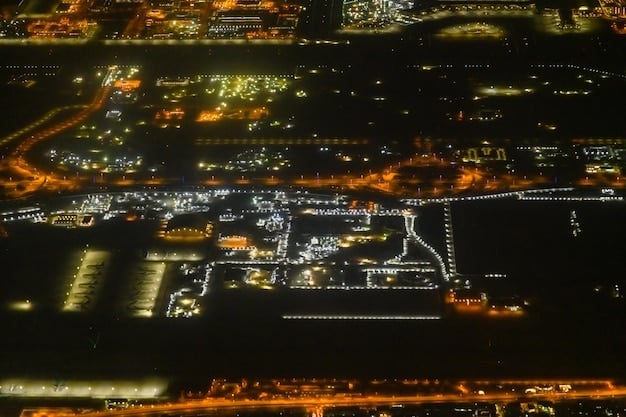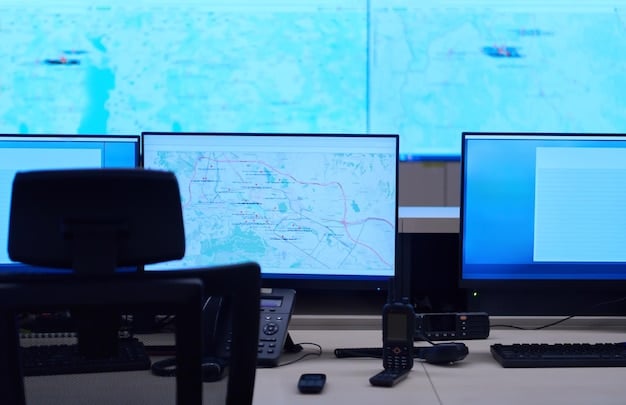Crime Mapping Tech: Data-Driven Law Enforcement in the US

New technology in crime mapping empowers local law enforcement in the US to analyze data, predict crime hotspots, and allocate resources effectively for proactive crime prevention and improved public safety.
The landscape of law enforcement is constantly evolving, and one of the most significant advancements is the integration of new technology in crime mapping. Across the US, local law enforcement agencies are leveraging data in unprecedented ways to understand crime patterns, predict future incidents, and ultimately, fight crime more effectively.
The Evolution of Crime Mapping Technology
Crime mapping has come a long way from pin maps on corkboards. Today, sophisticated technologies are transforming how law enforcement agencies analyze and respond to criminal activity.
These advancements are not just about visualizing crime data; they’re about gaining deeper insights and developing more effective strategies.
From Pin Maps to Predictive Analytics
Traditional crime mapping relied on manually plotting crime locations on a map. This method, while helpful, was limited by its static nature and the inability to analyze complex relationships between different variables.
The shift to digital platforms allowed for more dynamic mapping but the biggest leap forward has been the adoption of predictive analytics that allow patterns to be indentified.
- Geographic Information Systems (GIS): GIS software allows agencies to layer various data points onto maps, creating a more comprehensive view of crime patterns.
- Data Visualization Tools: These tools help officers and analysts visualize data in different ways, uncovering correlations that might not be apparent in tabular data.
- Predictive Policing Algorithms: These algorithms use historical crime data to forecast where and when future crimes are likely to occur.
These elements help modernize crime fighting, by reducing the amount of crime that occurs everyday.

The evolution of crime mapping allows officers to quickly identify trouble hotspots.
Predictive Policing: Using Data to Anticipate Crime
Predictive policing is one of the most promising applications of new technology in crime mapping. By analyzing historical crime data, law enforcement agencies can identify patterns and predict where future crimes are likely to occur.
This proactive approach allows them to allocate resources more effectively and potentially prevent crimes before they happen.
How Predictive Policing Works
Predictive policing algorithms analyze vast amounts of data, including:
- Historical Crime Data: Past crime incidents, including type, location, and time of day.
- Demographic Data: Population density, income levels, and other demographic factors.
- Environmental Data: Weather patterns, traffic flow, and proximity to schools or businesses.
All of these combined give a better indication of when a crime may occur.
Based on this data, the algorithms generate risk assessments, identifying areas and times with a high probability of criminal activity.
Benefits and Challenges
Predictive policing offers several potential benefits:
- More Efficient Resource Allocation: By focusing on high-risk areas, agencies can deploy officers and resources more effectively.
- Crime Prevention: Proactive policing can deter criminals and prevent crimes from occurring.
- Improved Community Relations: By reducing crime rates, predictive policing can improve community relations and trust in law enforcement.
However, there are also challenges associated with predictive policing:
- Data Bias: If the data used to train the algorithms is biased, the resulting predictions may also be biased, potentially leading to discriminatory policing.
- Privacy Concerns: The collection and analysis of large amounts of data raise privacy concerns, especially if the data includes personal information.
Despite these challenges, predictive policing holds the great promise of helping to keep all americans safe.
Real-Time Crime Mapping: Responding to Incidents as They Happen
Real-time crime mapping takes crime analysis to the next level by providing law enforcement agencies with up-to-the-minute information about criminal activity as it unfolds.
This allows them to respond more quickly and effectively to incidents, improving public safety and potentially saving lives.

How Real-Time Crime Mapping Works
Real-time crime mapping systems integrate data from a variety of sources, including:
- 911 Calls: Information from emergency calls is immediately displayed on the map, providing officers with crucial details about the incident.
- Computer-Aided Dispatch (CAD) Systems: CAD systems track the location and status of police vehicles, allowing dispatchers to send the closest available unit to the scene.
- Surveillance Cameras: Live feeds from surveillance cameras can be integrated into the map, providing officers with a visual overview of the area.
Agencies must be carefully about where they place surveillance cameras to avoid communities concerns.
Many law enforcement agencies have installed license plate readers in their real-time crime mapping systems in order to track vehicles associated with crimes.
Benefits of Real-Time Crime Mapping
Real-time crime mapping offers several key benefits:
- Faster Response Times: By providing officers with up-to-the-minute information, real-time crime mapping can help them respond more quickly to incidents.
- Improved Situational Awareness: Real-time maps give officers a more complete understanding of the situation on the ground, allowing them to make better decisions.
- Enhanced Officer Safety: By providing officers with information about potential threats, real-time crime mapping can help them stay safe while on duty.
These features allow them to stay on top of active criminals, especially during active investigations.
The use of real-time crime mapping can greatly impact how a police officer makes decisions.
Challenges of crime mapping technology
Despite the benefits of new technology in crime mapping, there are challenges. Many things have to be taken into consideration when crime mapping tech is used, due to potential security concerns.
Making sure that the technology has a good design is also imperative to making the best use of the resources.
Ethical Concerns
Bias in algorithms and data collection could have huge impacts on communities. Many wonder if this tech favors a particular group.
How law enforcements polices neighborhoods using this tech is a serious question. All stakeholders involved in criminal justice need to know the impact of AI.
Resource Allocation
Implementation that balances the resources within the agency’s budget is something that is very important for many local agencies.
Staff training is also a high concern, because of the complexity that this crime fighting tech carries. Local agencies have to allocate resources to this area to grow.
All these factors could be very impact full but need to be taken into more consideration.
The Future of Crime Mapping
The future of crime mapping is likely to be shaped by several trends:
As technology continues to evolve, crime mapping will become even more sophisticated and effective in helping law enforcement agencies prevent and solve crimes.
Artificial Intelligence and Machine Learning
AI and machine learning are poised to revolutionize crime mapping. These technologies can analyze vast amounts of data to identify patterns and predict future criminal activity with greater accuracy.
- Natural Language Processing (NLP): NLP can be used to analyze police reports and other documents, extracting valuable information about crime trends.
- Computer Vision: Computer vision can analyze surveillance footage, identifying suspicious activity and alerting law enforcement.
- Predictive Analytics: Machine learning algorithms can be used to develop more sophisticated predictive policing models.
These new forms of tech can really help crack down crime rings within the USA more efficiently.
Integration with Other Technologies
Crime mapping is increasingly being integrated with other technologies, such as:
- Body-Worn Cameras: Data from body-worn cameras can be integrated into crime maps, providing officers with a more complete picture of the incident.
- Social Media: Social media data can be used to identify potential threats and monitor crime trends.
- Smart City Technologies: Crime mapping can be integrated with smart city technologies, such as smart lighting and gunshot detection systems.
All of these new technologies, when working together, can come together to solve larger issues.
Community Engagement with Crime Mapping
New technology in crime mapping isn’t just for law enforcement. Engaging the community is key to fostering trust, transparency, and collaboration in crime prevention efforts.
By involving residents in the process, agencies can gain valuable insights and build stronger relationships with the communities they serve.
Transparency and Data Sharing
Open data initiatives and community portals allow residents to access crime statistics and maps, fostering transparency and accountability.
This also empowers communities to be more informed about crime in their neighborhoods and participate in solutions.
- Interactive Maps: Online tools that allow residents to explore crime data, report incidents, and share information with law enforcement.
- Community Meetings: Open forums where law enforcement and community members discuss crime trends, concerns, and solutions.
- Social Media Engagement: Utilizing social media platforms to share crime prevention tips, alerts, and resources with the community.
All this info being easily accessible can have so many huge impacts.
Collaborative Problem Solving
When communities are actively involved, law enforcement can leverage local knowledge and insights to address the root causes of crime.
This also promotes a sense of shared responsibility and empowers residents to become active participants in building safer neighborhoods.
- Community Policing Initiatives: Programs that focus on building relationships between officers and residents, encouraging dialogue and trust.
- Neighborhood Watch Programs: Organized groups of residents who work together to monitor their neighborhoods and report suspicious activity.
- Restorative Justice Practices: Approaches that involve community members in addressing criminal behavior and repairing harm.
Having the community engaged and working with local law enforcements can solve many cases.
| Key Point | Brief Description |
|---|---|
| 📍Predictive Policing | Uses data to forecast crime hotspots for resource allocation. |
| 🚨Real-Time Mapping | Provides up-to-the-minute incident data for faster response. |
| 🤖AI Integration | Enhances analysis and prediction accuracy using AI. |
| 🤝Community Engagement | Involves residents to improve trust and collaborative solutions. |
Frequently Asked Questions
▼
Crime mapping is the process of analyzing and visualizing crime data to identify patterns, trends, and hotspots. Law enforcement agencies use it to allocate resources, predict future crimes, and develop effective prevention strategies.
▼
Predictive policing uses algorithms to analyze historical crime data, demographic information, and environmental factors to forecast where and when future crimes are likely to occur. This allows agencies to proactively deploy resources.
▼
Ethical concerns include data bias, privacy violations, and potential discrimination. If the data used to train AI algorithms is biased, the resulting predictions may lead to unfair or discriminatory policing practices.
▼
Communities can get involved through open data initiatives, interactive crime maps, community meetings, and neighborhood watch programs. Collaboration between law enforcement and residents can improve trust and identify effective crime prevention solutions.
▼
Crime mapping is integrated with technologies such as body-worn cameras, social media, smart city technologies, real-time surveillance systems, and computer-aided dispatch (CAD) systems to provide a comprehensive view of criminal activity.
Conclusion
As technology continues to advance, new technology in crime mapping will continue to evolve and provide value to law enforcement agencies. By using these techniques and strategies, local law enforcement will be able to effectively monitor crime and prevent such things of that nature.





